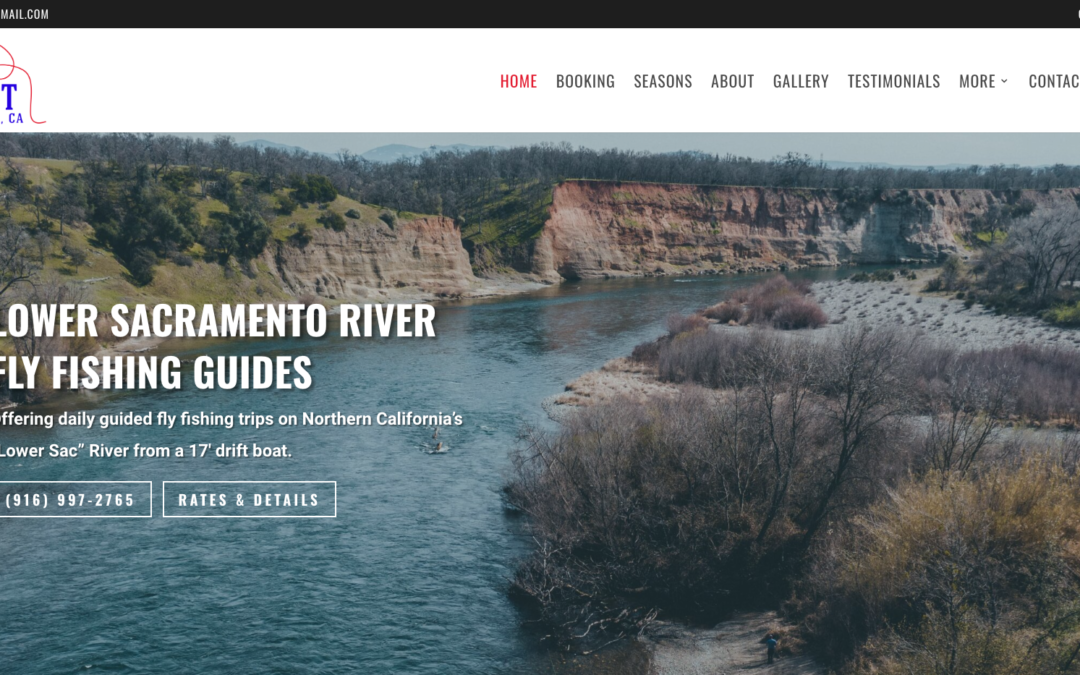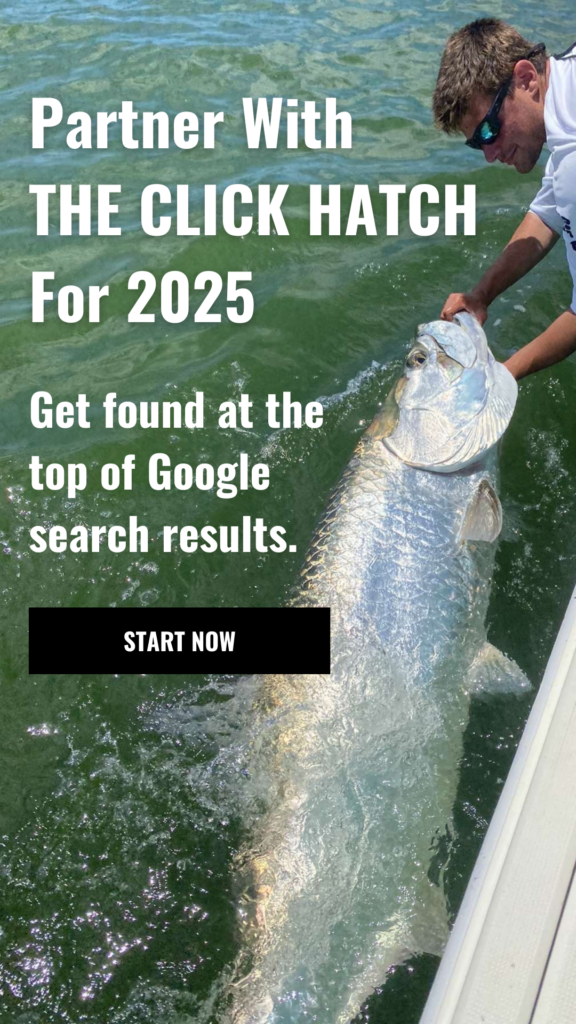You’ve likely heard the phrase, “If you build it, they will come.”, from the 1989 film Field of Dreams with Kevin Costner. If only that rang true for fishing charter website design.
Don’t cut corners, don’t let your buddy build it, don’t try to do it in a single weekend… You get it.
Do you want people to think you’re the go-to guide in your area?
Do you want to win new business by presenting the best first impression possible?
The answer is yes because you’re on this website about how to improve your fishing charter website design. Put time, thought, and energy into your website, and you’ll end up with an online homebase that’s constantly working for you in the background – churning out trips & building a client list instead of sitting anchored at the bottom of search results doing nothing for you.
Make Your Fishing Website A Workhorse
The Foundations of a Good Fishing Website
You’ve purchased a domain name and hosting plan and have been hard at work crafting your new site. Before we move on to fishing charter website design improvements aimed at generating more inquiries, let’s make sure we have the foundations of a good website design in place first. At minimum, we recommend having the following four pages:
- Homepage – Use high-quality visuals that best represent your business as a local leader, highlight any seasonal or high-value trips, include testimonials if possible, and make it easy for people to take your desired actions (call, form, direct emails, online bookings, newsletter sign up, etc.).
- Rates – Clearly describe the different trips you offer and be transparent about booking policies like deposits, cancellations, and refunds.
- About – Give potential clients insight into your background, add bios for guides, and list any relevant certifications.
- Contact – Instead of just listing your contact details, give your final sales pitch for why someone should reach out to you, and what kind of response they can expect in return (timeframe, call vs email).
But again, you’re not here for the bare minimum. You could stop there, and you could still book trips if you’re actively pushing people to your site through social media or word of mouth, but just slapping together the basic pages and hoping it’s impressive enough to win over savvy clients will leave you wondering why no one new ever finds their way to it.
You want your website to be a workhorse.
A workhorse website should:
- Passively attract the right people
- Impress at first-glance
- Be educational
- Convert new visitors into leads
Optimizing Your Fishing Website For Lead Generation
The “workhorse website” concept is all about making your site passively attract highly qualified people 24/7 – so you can focus on having conversations with leads, booking trips, and of course – fishing.
In our experience, these aren’t recommendations – they’re must-do’s on the path to building a website that actually works. These strategies are meant to get your website to a place where you can confidently send relevant traffic with the expectation that visitors will convert into leads.
Implement the following fishing charter website design tips to turn your site into a workhorse:
1.) Always design with phones in mind.
Over half of the website traffic across the internet comes from mobile devices, and 62% of Google Ads traffic comes from mobile. For fishing guide Google Ads accounts managed by our team at The Click Hatch, website traffic is almost always 80%+ mobile just due to the industry and how people typically search for guided trips.
This should leave no wonder why it’s our #1 must-do. Avoid the dreaded “pinch & zoom” by making sure your website is “responsive” and adjusts based on the screen size it’s being viewed on. The mobile version of your website should look clean and be easily readable, and remember not to bury your calls-to-action at the bottom of the page.
2.) Provide multiple opportunities to call.
Your phone number should be visible in multiple locations. We like seeing it on your contact page, in your header and footer sections, and at least once on your homepage. The number used should follow the same format across the site – for example, if you add (###) ###-#### on your contact page, the numbers displayed elsewhere should follow the exact same format. This is a critical step for accurate phone call tracking once you’re ready to scale your lead generation efforts with Google Ads.
3.) Clear location callout “above the fold”.
Workhorse websites are driving new people to your website all the time, and the first thing potential clients will want to know is where you’re based. Use the top section of your homepage to quickly call out your location, or if you’re in an area where the river or lake is the primary destination, include those keywords so people feel like they’re in the right place. This also helps Google get a better understanding of what phrases to rank your site for and how to position you in the map section of search results.
4.) Pass the vibe check with a personal video.
When the average website visit is about 30 seconds, and most of your website is coming from phones, is your website really set up to educate first-time website visitors on why they should book with you over your competitors?
Every fishing charter, fly fishing guide service, fishing lodge – anyone offering paid fishing trips – needs to have a simple video on their homepage that follows these guidelines:
- 30 – 90 seconds in length – longer is ok, but get to the point early on.
- Show your face! The video should look like someone is about to tell the website visitor something important. We’ve seen improved results from videos of just someone talking, versus highlight reel style of fishing with a voice overlay.
- Introduce yourself, where you’re located, explain the trips you offer, and why people should book with you.
- Quickly tell people what they can expect seasonally from you, or create seasonal videos to match the changes in your fishery.
- Encourage people to reach out through your preferred method (call/text, on-site contact forms, online booking, etc.).
This video acts as an elevator pitch for your fishing charter website, and allows people new to your business the chance to learn everything they need to know about your operation to decide if they’re in the right place or not. This is the “vibe check”. Someone can search “fishing charters in YOUR LOCATION” or “YOUR RIVER fly fishing guides”, and get all of the important details they need with one short video. The video works to pre-qualify who’s reaching out to you, and by the time they contact you, they know what you look like, they’ve heard your voice, got a feel for your personality, and know whether or not they want to spend the day with you.
Plus, most Google users will do a search like “YOUR LOCATION fishing guides” and look at more than one business – getting different first impressions, price shopping, reading guide bios, etc. – make your fishing website stand out with a personal video that quickly builds a connection with potential clients.
And the best part? It’s $FREE.99. All you need is a phone and to get past the fear of putting your face on camera – which is the most common pushback we hear on this one : ) Click here for more video examples from The Click Hatch clients.
Here’s a client example:
Journey On The Fly based near Pittsburgh, PA offers guided fly fishing trips for just about anything that bites as the seasons change. One of those seasons however, is an epic steelhead run out of Lake Erie during the cold months. In order to make his website more relevant to people looking for for steelhead trips, we set up a specific page all about steelhead and he recorded a 4-minute video which nails the personal aspect. The video image shows the head guide, you can feel his passion, and he walks you through everything you need to know about spending the day chasing chrome with him. If someone watches this entire video, there’s a really strong chance you’re booking that trip.
5.) Strengthen your fishing website by building pages that match search queries.
The foundational pages mentioned above are a good place to start, but you want to continue strengthening your website by adding pages to support potential clients through their decision making process. These additional pages will help keep visitors on your site for longer and position your business as a leader in your market, and in the background it gives Google more opportunities to rank you in search results earning your more free website traffic over time.
Let’s use a new fly fishing guide service in Bozeman, MT as an example. Here are some potential pages or blog posts they could create to support the services offered and provide value to website visitors and increase the chances of being found in Google search results:
Service-Based
These pages are meant to support fishing-specific search queries, in relation to your trips and location. By giving Google more fishing-related pages to rank in search results, even for queries that don’t include intent keywords like guide, trip, float, outfitter, or fly shop, this guide service in Bozeman can get free site traffic from people who could be interested down the line. Or maybe they just didn’t include an intent keyword but they actually are looking for a guide.
Being found for phrases like “madison river fly fishing”, “float fishing trips near Bozeman”, or “best fishing near Bozeman in March” still helps you grow an audience of relevant website visitors you can then stay in front of for up to a year and a half (more to come on remarketing with Google Ads).
- Trip offerings
- Single-day trips, multi-day trips, float fishing trips
- Where you fish
- River breakdowns (Madison, Yellowstone, Gallatin, etc.)
- Fishery seasonality
- Local fisheries by month, by season, tactics
Value-Based
The purpose of value-based pages is to attract people who may not have been searching for fishing but could still be interested in a trip, or to support your clients in their overall experience in your area. You want these to stand on their own, but tie in fishing without being overly promotional. For example, this guide service could write a page about “Best Things To Do Near Bozeman MT” (which is a commonly searched phrase in any market), and use a guided fishing trip on the Upper Madison River as the 3rd thing to do on the list. It’s subtle, but it helps position your trips as an option to people who otherwise may have never searched for fishing.
You’ll notice in the example phrases below that the bolded words reflect how someone would search to find this content – your URL, title, and page content should match the phrase you want your page to be shown for.
- Best Things To Do Near Bozeman MT
- The Best Time Of Year To Visit Bozeman
- Our Favorite # Places To Stay Around Bozeman
- # Bozeman Breweries Worth A Stop
Whether it’s a service or value page, these supporting pages should have:
- Titles that reflect how someone would search to find that info
- Minimum of 3 paragraphs of text content (including relevant keywords)
- High-quality images that support the page content
- Clear call-to-action (call now, submit a form, book online)
- Custom URL that reflects the title/keywords (not yoursite.com/page7)
Need help with your fishing charter website design? Let’s talk.
The Click Hatch works with fishing charters, guides, and lodges all over the place to improve websites and generate leads. Let’s get your website showing at the top of Google search results! Start a conversation with us below.


